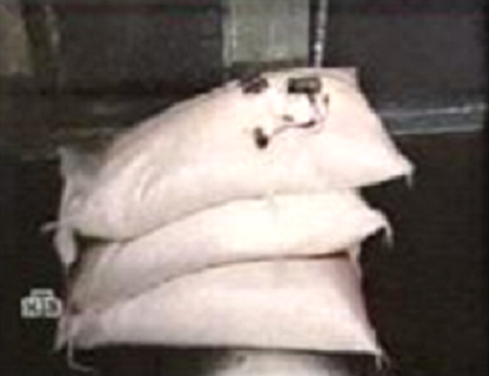Filed Under: Material culture > Arts or design > Ryazan Sugar (Hexogen)
Ryazan Sugar (Hexogen)

Three large sacks wired to a timer set for 5:30 am were found in the bottom of a Ryazan apartment building on 22 September 1999. The sacks were later said to contain sugar as part of a training exercise.
In early September 1999, four explosions in residential buildings across Russia spread fear and uncertainty, ultimately leading to the Second Chechen War (1999-2009). The bombings, which killed over 300 people in Buynaksk, Moscow, and Volgodonsk, were all executed with explosive devices placed in the basements of large apartment buildings and set to detonate in the early morning, while residents still slept. Official Russian investigations concluded that the bombings were ordered by Chechen-connected warlords Ibn Al-Khattab and Abu Omar al-Saif (both of Saudi origin) and organized by Achemez Gochiyaev (a Russian citizen), but the accused men all denied responsibility. Nevertheless, the attacks, along with the invasion of Dagestan by the Chechnya-based Islamic International Peacekeeping brigade in August of that year, served as the justification for a renewed assault on Chechnya by Russian federal troops—including a siege of the Chechen capital, Grozny, that started in December 1999. Then-Prime Minister Vladimir Putin (1952-) won widespread approval for his prosecution of the conflict and easily won the presidency of the Russian Federation in March 2000.
The 1999 terrorist attacks have been shrouded in controversy since they occurred. After the first three bombings, the Speaker of the Duma, Gennady Seleznyov, announced that a fourth bombing had occurred in the relatively small city of Volgodonsk. Although that city indeed became the site of a fourth attack, it didn’t occur until three days after Seleznyov’s announcement. Despite this advance notice, however, the authorities were somehow unable to prevent it.
A few days later, another Russian city, Ryazan, had more luck. A resident called the police after seeing three individuals unloading large sacks into the ground floor of an apartment block. When the police arrived, they found the three sacks connected to a detonator set for 5:30 AM. The apartment building was evacuated and the police initially reported that traces of the explosive hexogen, which had been used in the previous attacks, had been found on the sacks. The day after the evacuation, the perpetrators had still not been found, but Vladimir Putin praised the vigilance of Ryazan citizens. Soon, however, FSB chief Nikolai Patrushev told a TV reporter that the sacks had contained nothing but sugar, and that the whole affair had been an internal exercise to test public vigilance. In the incident’s wake, skeptics coined a new term for explosive substances: “Ryazan sugar” (riazanskii sakhar), and the substance in question inspired the title of Aleksandr Prokhanov’s (1938-) conspiracy-minded 2002 novel Mr. Hexogen.
The full truth of the incident will likely never be known, but many of its consequences are quite clear. Most obviously, the bombings stoked public support for the Second Chechen War. If Chechen militants were capable of attacking citizens in central Russia, then the new president’s hard line and the military brutality it entailed were justified. But no less important, the incident showed the early appetite for conspiracy theories. Justified or not, conspiracy theories from across the political spectrum would soon cast ordinary Russians as the victims of nefarious forces that prioritize power grabs, greed, and politics over human life.
The 1999 terrorist attacks have been shrouded in controversy since they occurred. After the first three bombings, the Speaker of the Duma, Gennady Seleznyov, announced that a fourth bombing had occurred in the relatively small city of Volgodonsk. Although that city indeed became the site of a fourth attack, it didn’t occur until three days after Seleznyov’s announcement. Despite this advance notice, however, the authorities were somehow unable to prevent it.
A few days later, another Russian city, Ryazan, had more luck. A resident called the police after seeing three individuals unloading large sacks into the ground floor of an apartment block. When the police arrived, they found the three sacks connected to a detonator set for 5:30 AM. The apartment building was evacuated and the police initially reported that traces of the explosive hexogen, which had been used in the previous attacks, had been found on the sacks. The day after the evacuation, the perpetrators had still not been found, but Vladimir Putin praised the vigilance of Ryazan citizens. Soon, however, FSB chief Nikolai Patrushev told a TV reporter that the sacks had contained nothing but sugar, and that the whole affair had been an internal exercise to test public vigilance. In the incident’s wake, skeptics coined a new term for explosive substances: “Ryazan sugar” (riazanskii sakhar), and the substance in question inspired the title of Aleksandr Prokhanov’s (1938-) conspiracy-minded 2002 novel Mr. Hexogen.
The full truth of the incident will likely never be known, but many of its consequences are quite clear. Most obviously, the bombings stoked public support for the Second Chechen War. If Chechen militants were capable of attacking citizens in central Russia, then the new president’s hard line and the military brutality it entailed were justified. But no less important, the incident showed the early appetite for conspiracy theories. Justified or not, conspiracy theories from across the political spectrum would soon cast ordinary Russians as the victims of nefarious forces that prioritize power grabs, greed, and politics over human life.